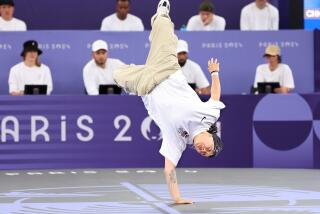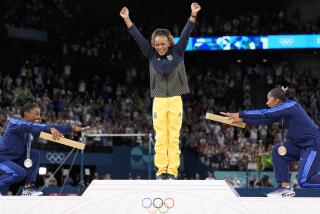Bright gives her fans a thrill
- Share via
ASPEN, COLO. — Gretchen Bleiler had the entire community behind her.
They carried placards that read “Super G,” in reference to their resident superhero.
But Torah Bright had dozens of fervent supporters who traveled all the way from Australia.
They stood at the bottom of the halfpipe Thursday after each of her runs, and ran to the top to cheer each of her starts.
“It was awesome,” the beaming 20-year-old said after winning her first X Games gold medal. “They were doing as much as I was.”
What the rising star from New South Wales did, on a starry night, was shine brighter than she ever has on so large an international stage.
Bleiler opened the best-of-two runs final with a seemingly insurmountable score of 91.00. But Bright used a series of difficult 720-degree variations on her second run to move into first to stay with a 94.66.
The top spot on the podium may be unfamiliar territory for Bright, but the second spot is becoming all too familiar for Bleiler, who finished behind teammate Hannah Teter at the Turin Olympics.
Still, Bleiler was gracious afterward, saying she could not land a single run during practice.
“It’s not a bad night for me at all -- I’ll take second,” she said. “Torah’s run was insane, pretty much flawless.”
In hot water
Bleiler is among prominent athletes, politicians, actors and businesspeople to have joined the Virtual March to stop global warming (stopglobalwarming.org).
“It’s something that I’m really excited to get behind because it’s affecting our sport; it’s so right in our face,” she said. “I was just in Europe and the temperatures felt like April.
“So for me it’s really close to what I do -- and my heart. It’s something we should all start thinking about.”
Plugged-in appliances. No good, the snowboarder says, as they still sap energy. Gas guzzlers? The worst.
Bleiler’s ride? “Why, I just bought a Lexus hybrid,” she said with a smile.
Staying alive
Will this be the year an athlete dies? That’s the burning question, privately anyway, among ESPN executives before every X Games.
“We talk about this before the broadcast: What if someone is killed? How are we going to deal with that?” said Sal Masekela, an action sports icon and veteran X Games commentator. “And that’s just a report that I hope I never have to make.”
When snowmobiles fly
Of measurable concern during X Games 11 (there have also been 12 summer versions) is Snowmobile Freestyle, making its X Games debut with a Sunday final.
It replaces freestyle motocross, or Moto X, which produced more than its share of injuries.
“Freestyle motocross doesn’t make sense,” Masekela said, stressing that he speaks strictly as a non-athlete in awe of the risks the athletes take. “That’s a 250-pound motorcycle and now you’re talking about 400- to 500-pound machines that are not built to fly.”
Snowmobile rider Chris Burandt said he and his friends used to fly over houses just for fun, and that his worst injury was torn ankle tendons suffered after landing on a flat spot.
“I’ve been pretty fortunate,” said Burandt, the top qualifier for Sunday’s final.
Hard knocks
Jimmy Fejes was among the walking wounded after Day 1. He face-planted in the snow while coming up short on a back-flip during Snowmobile Freestyle practice.
That came less than an hour after snowboarder Lindsey Jacobellis suffered a concussion while banging her head on the bottom of the halfpipe during practice for the final.
She withdrew from the final but is expected to compete in her specialty event, Snowboarder X.
Her accident came about an hour before Jay Quinlan suffered a rib injury when his snowmobile rolled over him after a crash during qualifying.
Because they were there
As an X Games color commentator, Chris Davenport won’t be taking home any medals, but he may be the most extreme athlete here.
Davenport, a big-mountain specialist from nearby Snowmass, recently became the first person to climb and ski all 54 of Colorado’s 14,000-foot peaks -- from absolute summit -- in a calendar year.
“It literally took everything I had for the whole year,” Davenport said.
“It took 100% dedication and was the most demanding thing I’ve ever done in my long skiing career.”
More to Read
Go beyond the scoreboard
Get the latest on L.A.'s teams in the daily Sports Report newsletter.
You may occasionally receive promotional content from the Los Angeles Times.






